How people get to work in the Capital Region
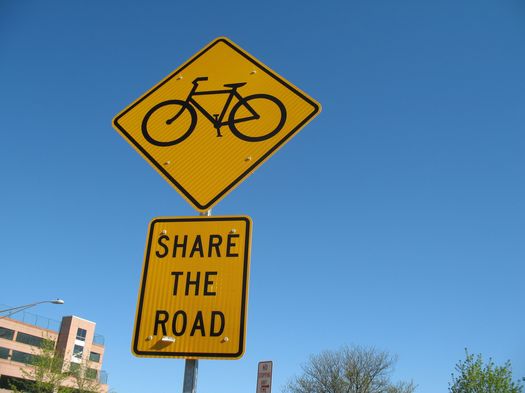
The way to get to work? Not for many, but it is for some people.
This Friday, May 16 is Bike to Work Day, which seemed like a good excuse to take a look at how people get to work in the Capital Region. And, thanks to the Census Bureau, there are some numbers that can give us some sense of that.
So, let's have a look -- at how people get to work, how long it takes them, and when they leave...
There are cars, and then everything else
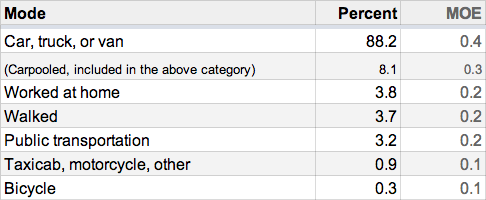
The overwhelming majority of people in the Capital Region get to work by car: about 88 percent, according to Census Bureau estimates. (In this case, Capital Region = the four core counties + Schoharie. MOE = margin of error.)
The table above shows the various modes of transportation with the Census estimates of what percent of workers 16 and over use that mode to get to work.
Relative to other modes of transportation, very few people in this area ride a bike to work -- though it's still about 1,300 people. (That number is squishy because the margin of error is so large relative to the estimated percentage of people.)
That's not surprising given we're looking at the whole Capital Region. If you zoom in on a few of the denser places within the region, the rates do increase a bit. But even so, Albany leads the Capital Region in the estimated percentage of people who bike to work -- and its estimate is just .9 percent. (That's about 400 people.)
More tables and graphs
There are a bunch of other Capital Region commuting bits in graphs, tables, a map above -- click or scroll all the way up.
National
Though the number of people nationally who bike is small, it is growing, according to a Census Bureau report out recently. And in the nation's largest cities, it figures the rate is now about 1 percent (up from .6 percent a decade ago).
The big city with the highest rate of bike commuting: Portland, Oregon, at 6.1 percent. (Surprise.)
The Census Bureau also noted that people were most likely to walk to work in the Northeast (4.7 percent) and in college towns. In fact, Ithaca, New York led the nation's small cities in the percent of people who walked to work -- 42 percent.
All numbers via the Census Bureau American Community Survey 2012 5-year.
Say Something!
We'd really like you to take part in the conversation here at All Over Albany. But we do have a few rules here. Don't worry, they're easy. The first: be kind. The second: treat everyone else with the same respect you'd like to see in return. Cool? Great, post away. Comments are moderated so it might take a little while for your comment to show up. Thanks for being patient.
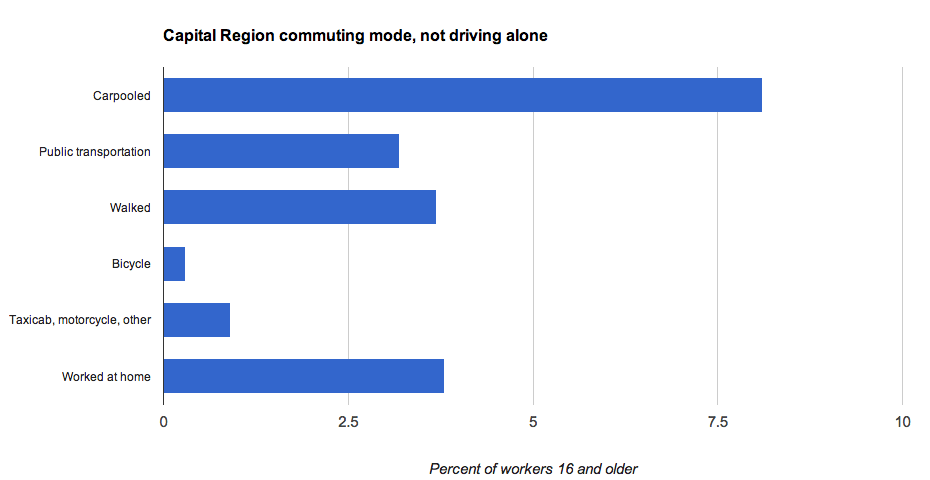
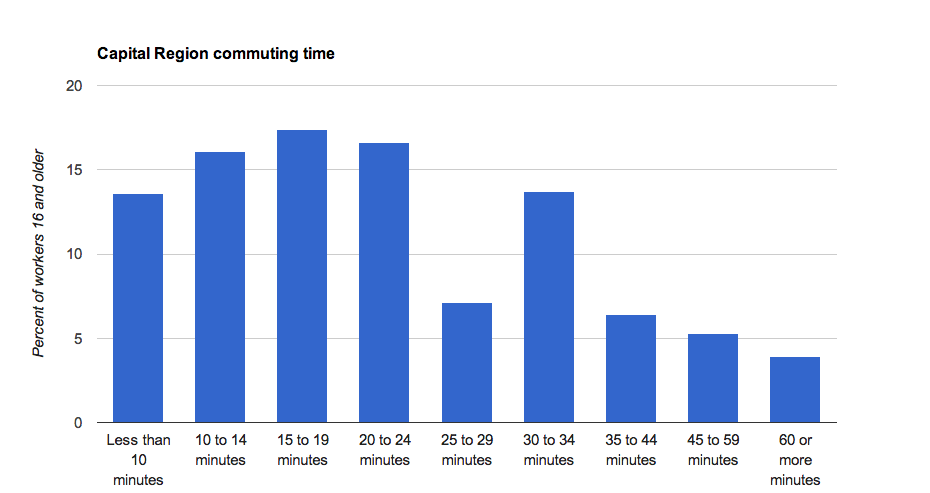
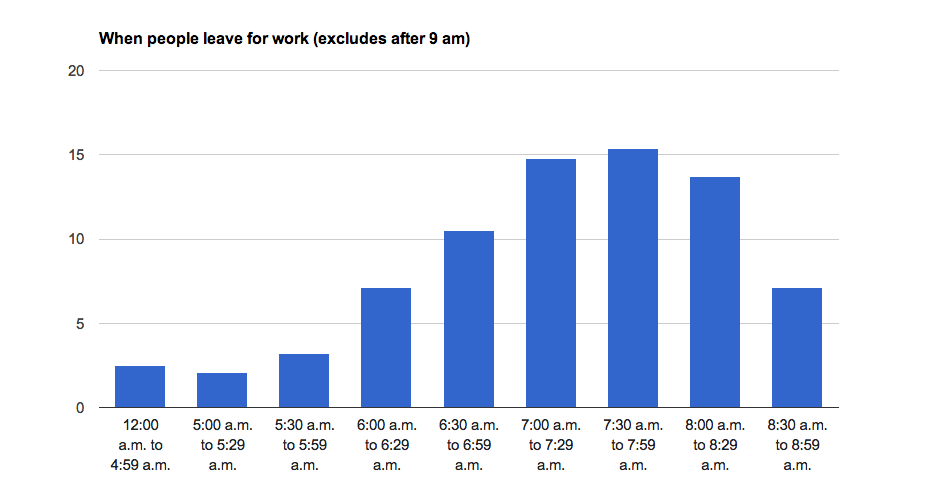

Comments
For those of us who don’t want to bike through thunderstorms on Friday, remember that Bike to Work Day is always surrounded by Bike to Work Week (May 12-16) and Bike to Work Month (May). So you can’t go wrong. You have no excuse to stay on your butt. I’ll be biking in tomorrow but probably not Friday…
... said Ryan on May 14, 2014 at 1:28 PM | link
I love walking to work. But I'm lucky in that I only live less than a mile from my work. I don't think that happens very often in our culture since most people prefer to live in the suburbs and work in a city. But that's changing...slowly.
... said Danielle Sanzone on May 14, 2014 at 1:33 PM | link
A local connection: the author of the Census Report - Brian McKenzie - received his PhD from UAlbany's Department of Sociology (and used to ride his bike to school/work).
... said kells on May 14, 2014 at 2:28 PM | link
I loved riding my Vespa to work... but OGS took away my motorcycle parking. (WTF right?)
I am thinking about riding my bike to work, but... my cyclocross bike is really a terrible commuter... :)
... said Andy on May 14, 2014 at 3:41 PM | link
If Albany wants to get serious about biking, we need to install protected bike lanes or separate bike paths. We are really behind on that front compared to many other cities.
... said Paul on May 15, 2014 at 8:54 AM | link
I have a 4.9 mile commute - mainly straight on Central Avenue in Albany.
If I drive, it's 12-15 minutes with traffic.
I love to walk it - it takes about 1 hour and 20 minutes (I have to get up REALLY early for that!) At the end of the work day, I want to be home ASAP, and the walk is not nearly as peaceful as early in the morning, so those days sometimes I'll take the bus.
It would be a very reasonable commute by bicycle, but there is NO WAY I'm brave enough to ride my bike in rush hour traffic on Central Avenue.
... said capgirl on May 15, 2014 at 10:50 AM | link
Count me in the bus/walk category. About 25 minutes all together to get home, but if I want to head downtown from work, its a quick 10 minute bus ride, and no worries on finding parking.
... said Rich on May 16, 2014 at 12:20 PM | link
I agree with Paul. It's time for protected bike lanes in our region. Here's a great infographic from the People for Bikes website that provides a snapshot of 14 options that measure protection level, installation cost, durability and aesthetics: http://www.peopleforbikes.org/blog/entry/14-ways-to-make-bike-lanes-better-the-infographic
... said Leah Golby on May 16, 2014 at 12:27 PM | link
Protected bike lanes would be great. Although designs have been drawn up put Madison Avenue on a "road diet"-- changing it to two moving lanes and a turning lane in the middle, and adding bike lanes on either side-- plans for separated bike lanes were never considered. I think that most of this is financial-- the city simply does not have a lot of money.
We can push municipal representatives to move projects like the Madison Avenue redesign forward (as modest as it is), however, and there are other low-cost, common-sense measures the city can take to make biking, mass transit, and even being a pedestrian more pleasant. A city that is less car-dependent is always going to be a nicer city to live and work in.
... said Alex on May 17, 2014 at 10:52 PM | link
RE: Protected bike lanes and dedicated paths; JMO, but...no. No, no, no, no...no. Not that they don't serve a purpose, and more would be great, but if you want a comprehensive bike-friendly city, that is not the place to *start*. If you want bikeability, you need to influence drivers (and riders/cyclists) with smart street design, signage, paint, etc., and by keeping bikes visible (i.e. on the streets, not quarantined to separated paths). If the roads themselves are well designed, well maintained, and drivers understand the bikes belong there, then cycling becomes a mode of transportation rather than just a recreational activity.
... said Ed on May 19, 2014 at 4:04 PM | link
@Ed - From your post, it's my assumption that you are comfortable riding with traffic. (Of course, I could be wrong...that happens). You may know that here in the city of Albany we've been putting up lots of shared road markings, and it's a step. However, it isn't getting the bicycle-curious (yet traffic-timid) folks out of their cars and onto their bikes. If we want to do that, we need protected bike lanes.
... said Leah Golby on May 20, 2014 at 10:26 AM | link
@Leah - point taken. FWIW, I dont ride in Albany much; my commute is either on the bike path (50% longer than fighting motorists on the road) or, if I want to triple the duration, rural roads. I am comfortable in traffic, but not the typical urban/suburban capital district traffic (i'm rarely comfortable driving in it, much less riding). And that was my point; yes, markings are showing up more, and that is to be commended (thank you), but the product is inconsistent and that can make things more confusing for motorists and cyclists alike. You shouldn't have to be brazen and fearless to feel comfortable in traffic (which you pretty much do, now). The truly "traffic timid" will probably never hit the streets, and that's fine; protected lanes and paths serve their purpose. But I should be able to comfortably ride city streets and commuter routes without fearing for my life. If riders are visible in the streets, that also provides more incentive for the bike-curious to give riding (wherever it may be) a shot. Unless there is some way to plan and fund a comprehensive network of protected lanes without introducing additional safety and logistical concerns, I simply don't see them as a feasible primary objective. A couple protected lanes along specific routes might make for some good opportunities on their own, but without a comprehensive message, it continues to tell motorists that bikes don't belong on the street. If a comprehensive protected lane/protected intersection system could be funded and implemented, that would be fantastic. But...yeah....
... said Ed on May 20, 2014 at 1:31 PM | link
@Leah- Do you think that the bicycle-curious/traffic-timid crowd could be helped along with a class or meet-up group rather than dedicated protected lanes?
I mention this only because I was one of those bicycle curious people up until recently. My regular route was to ride the bus from downtown Troy with my bike on their rack and get off at HVCC to pedal through a suburban neighborhood for 3 minutes towards my job. Then I'd do the opposite on my ride home.
After missing my bus one day, I just took the plunge and rode the 4 miles home. It was TERRIFYING but mostly because I had never done it before. I'm aware I got lucky with most drivers being respectful (except for the one guy in the lifted truck with the truck nuts).
I acknowledge I can't speak for everyone, but I would have started riding home a heck of a lot sooner had I had some experience biking on roads in a group or even taken an hour long verbal course about what to actually expect while riding in traffic. Up until I did it, I just imagined it would be an endless series of near misses and people throwing 5 Hr energy bottles at my head from their Honda Civics. As it turned out, it was just a few sweaty moments in a couple of spots that are equally as tricky for drivers and some mild sexual harassment from a guy who felt the need to have red rubber testicles hanging from his trailer hitch!
Maybe it's something that could be partnered with CDTA?
... said CMaxby on May 20, 2014 at 2:07 PM | link
@CMaxby - I've been interested in this for a while. Other cities have a variety of options for bringing bike-curious folks up to speed in traffic.
Some cities have what they call a bike train, which follows a pre-planned, pre-scheduled route through the city- anyone can join the group & leave as necessary. Safety in numbers, some socializing, & at least one "fearless" leader.
Other cities have groups that provide a sort of buddy system. You can say "I'm going from x to y at z o'clock" & people can pair/group up.
The biggest step here is getting a group of experienced cyclists willing to volunteer their time to show other people around, probably a few times. & then spreading the word. I think Albany could really benefit from something like this, but it's a huge lift.
... said ethan on May 20, 2014 at 3:05 PM | link
This is a city where motorists have a difficult enough time with concepts like "stop sign." I would rather bike everywhere, but am not comfortable with traffic and it seems like an unacceptable risk. Tried biking to work once; experience was bad enough that I sold my bike.
... said LB on May 20, 2014 at 3:27 PM | link
@CMaxby & ethan - NYBC is offering a "traffic skills" course for $5. Probably a bit more in-depth (9 hours http://nybc.net/traffic-skills-101/) than you are proposing but would be a great value.
There are a few cycling meetups, and the mohawk hudson cycling club has a large amount of group rides with a variety of levels, which could be a good way to get comfortable on the roads. Albany Bike Coalition has regular meetings and events. Getting the word out is the tough part. And not everybody wants to join a group. Signs and markings are (semi-) permanent messages that empower cyclists by saying "you belong here." I think anyone starting out can benefit from a 15 minute talk or even just a flyer on road safety, but getting the info to them isn't always easy.
... said Ed on May 20, 2014 at 4:09 PM | link
@CMaxby & @Ethan - If you have the time, sign up for the Traffic Skills course this week mentioned above (http://nybc.net/traffic-skills-101/). It will be worth it!
And if you can't make it, get in touch with the folks at Capital CoExist (http://www.capitalcoexist.org/) / Capital Moves (http://capitalmoves.org/) because they can point you in the right direction of future traffic skills courses.
... said Leah Golby on May 21, 2014 at 7:19 AM | link